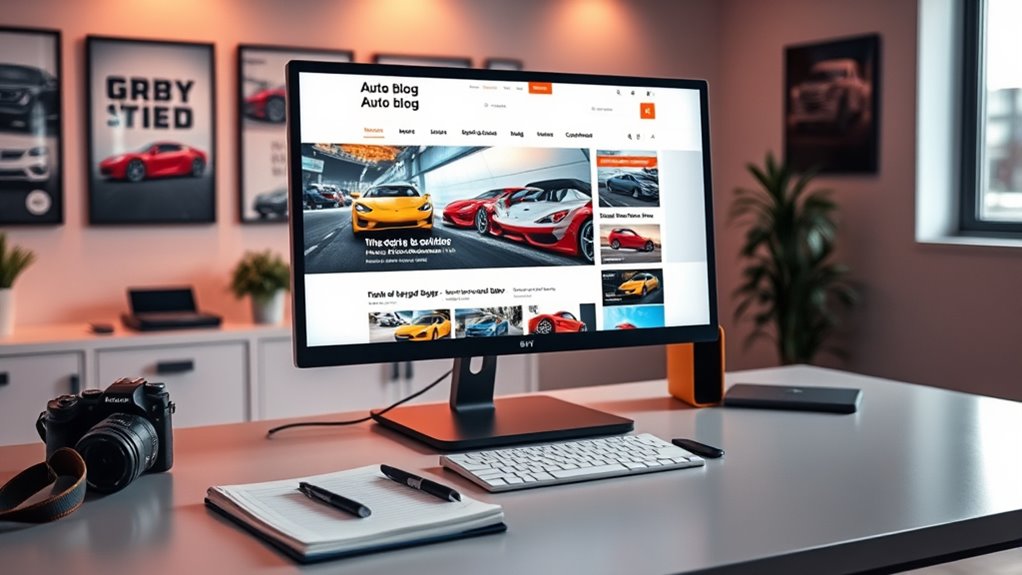To reach 10K monthly visitors, focus on targeting high-value and long-tail keywords, creating detailed content about vehicle features, and maintaining a consistent publishing schedule. Optimize your on-page SEO, including titles, headings, and meta descriptions, to improve search visibility. Track your performance using analytics, making adjustments to boost engagement and growth. Keep refining your strategies and scaling your efforts—staying persistent is key. If you continue exploring, you’ll uncover even more effective growth tactics.
Key Takeaways
- Implemented targeted keyword research focusing on high-value and long-tail keywords to attract niche and relevant traffic.
- Developed comprehensive, well-structured content around core pillars like car buying guides and industry trends to boost authority.
- Maintained a consistent publishing schedule, leveraging an editorial calendar for diverse content formats aligned with seasonal events.
- Optimized URLs, meta descriptions, and internal links to improve search engine visibility and user navigation.
- Monitored analytics regularly to refine strategies, identify trending topics, and enhance content performance for sustained growth.
Identifying High-Value Niche Keywords in the Auto Industry

To effectively grow your auto blog, you need to identify high-value niche keywords that attract targeted traffic. Focus on keywords like “automotive safety” and “car maintenance,” which address specific concerns of your audience. Automotive safety keywords, such as “car safety tips” or “vehicle safety features,” draw users interested in protecting themselves and their vehicles. Car maintenance keywords, like “DIY car repair” or “regular car maintenance checklist,” appeal to car owners seeking practical advice. These niche keywords often have moderate search volumes with lower competition, making it easier for your content to rank. By integrating relevant keywords that match search intent, you’ll attract highly targeted visitors, increasing engagement and conversions. Research indicates that focusing on specific, less competitive keywords can significantly improve your rankings. Incorporating Volkswagen Tuning content can further attract enthusiasts seeking modifications, boosting your traffic. Effective keyword selection is essential for building authority and driving consistent traffic to your auto blog.
Developing Targeted Content for Specific Vehicle Features

Focusing on specific vehicle features helps you create content that resonates with your audience. By analyzing trim options, highlighting color choices, and detailing accessory features, you can address what drivers care about most. This targeted approach boosts engagement and positions your blog as a trusted resource. Additionally, incorporating relevant keywords related to these features can improve your website’s SEO, making it easier for potential readers to find your content organically. Enhancing visibility ensures your content reaches the right audience and drives more traffic to your blog. Understanding essential oils and their application can even inspire creative ways to connect with readers interested in wellness topics.
Analyzing Vehicle Trim Options
Understanding vehicle trim levels is essential for creating targeted content that resonates with potential buyers. By doing a trim comparison, you highlight differences that matter most, such as safety tech or interior upgrades. Feature bundling in higher trims can deter some buyers, so emphasizing which features are available separately helps your audience make informed decisions. Additionally, knowing the best models of 2024 can help tailor recommendations to current market offerings.
Focusing on these distinctions allows you to craft content that appeals to diverse preferences. Clarify which features come bundled and which are optional, making your content more relevant and persuasive. This approach boosts engagement and guides users toward the right trim for their needs.
Highlighting Color Variations
Highlighting color variations can considerably enhance your vehicle content by appealing to regional preferences and emerging trends. By understanding vehicle color trends, you can craft targeted content that resonates with your audience. Consider these key points:
- Emphasize the dominance of white, gray, and black, reflecting color psychology’s association with professionalism and resale value.
- Highlight regional differences, like increased interest in brown/beige in Asia versus their rarity in the US.
- Discuss the decline of colorful options, showing how the market has become more homogeneous—yet, green is making a slight comeback.
- Use statistics to guide content on choosing colors for resale value and demand, helping buyers understand regional and global shifts. The overall color diversity has decreased significantly over time, with fewer colorful options available on the road.
Focusing on vehicle color trends helps you tailor content that appeals to diverse preferences and boosts engagement.
Detailing Accessory Features
In vehicle detailing, selecting the right accessories can make a significant difference in achieving a professional finish. Microfibre cloths offer numerous benefits, including high absorbency and gentle cleaning, making them essential for wiping and polishing surfaces without scratching. Detailing brushes, especially firm ones, are perfect for cleaning tight spaces and stubborn grime, like engine bays or vents. Using the right tools enhances precision and efficiency, ensuring each vehicle feature gets the attention it deserves. Microfibre benefits extend to glass cleaning, where waffle weave cloths deliver streak-free results. Combining these accessories with targeted techniques helps prevent damage and reveals a vehicle’s true shine. Incorporating quality detailing brushes and microfibre cloths into your routine elevates your results, making your detailing process more effective and professional. Proper tools ensure consistent results and help maintain the vehicle’s finish longer. Additionally, selecting tools with advanced cleaning technology can further improve cleaning efficiency and outcomes.
Building a Consistent Blogging Schedule to Boost Authority

To boost your authority, you need a reliable publishing routine that keeps your audience engaged. Planning regular content and integrating targeted keywords help uphold a consistent rhythm and improve search visibility. Sticking to a steady schedule ensures your readers know when to expect new posts and builds your credibility over time. Additionally, understanding cookie categories and management can enhance your website’s user experience and trustworthiness.
Regular Content Planning
Establishing a consistent publishing schedule is essential for building authority and maintaining steady growth. When you plan your content regularly, you create a reliable flow that keeps your audience engaged and signals authority to search engines. To maximize effectiveness, consider these strategies:
- Use Content Repurposing to adapt existing material into new formats, saving time and broadening reach.
- Schedule Guest Collaboration posts to diversify perspectives and tap into other audiences.
- Maintain a blog content calendar to visualize long-term plans and prevent gaps.
- Vary post formats—like how-to articles, lists, and opinion pieces—to sustain interest and reinforce your niche authority.
Consistent planning guarantees you stay on track, adapt easily, and build a recognizable, trusted voice in the auto industry.
Keyword Integration Strategies
Implementing effective keyword integration is essential for building authority through a consistent blogging schedule. Focus on placing primary keywords like “automotive design” and “engine technology” strategically in your blog title, meta description, headers, and within the first 100 words. Naturally incorporate these keywords into the content to maintain readability and avoid sounding robotic. Use them in image alt text and captions to boost search engine understanding of multimedia elements. Support your primary keywords with related terms and synonyms to broaden your reach without keyword stuffing. Prioritize long-tail keywords that target specific queries, such as “latest engine technology trends,” to attract niche audiences and improve rankings. Employ SEO tools and plugins to refine keyword placement and track performance, ensuring your content stays optimized and relevant. Additionally, understanding key concepts like content relevance can help tailor your posts to better meet search intent and audience interests.
Consistent Publishing Rhythm
Creating a consistent publishing rhythm is a powerful way to boost your blog’s authority and keep readers coming back. When you establish a predictable schedule, you strengthen your content diversification and audience segmentation efforts, making your blog more engaging. Consider these key points:
- Posting 1–2 times weekly helps small blogs grow authority and retain visitors. Frequent posting signals thought leadership, encouraging search engines to rank your content higher.
- Larger blogs aiming for 4–5 posts weekly maintain momentum and improve SEO.
- Regular publishing signals dedication to search engines, boosting rankings.
- Avoiding long gaps keeps your audience engaged and prevents drops in traffic.
Creating Deep, Well-Researched Pages That Engage Users

To truly engage your audience, you need to develop pages that are both deep and well-researched. Prioritize content depth by providing detailed information that thoroughly covers your topics, increasing the time visitors spend on your page. Use data, statistics, and expert insights to establish authority and build trust. Focus on understanding your audience’s needs and interests—address their pain points and questions with personalized, relevant content. This approach boosts user engagement and encourages repeat visits. Incorporate visuals like charts, graphs, or images to clarify complex points and keep readers interested. Well-researched, exhaustive pages not only satisfy diverse user intents but also support your SEO efforts through internal links and rich content, ultimately creating a more meaningful experience that keeps visitors coming back. content depth is essential for building credibility and providing comprehensive value to your audience. Tracking visitor interactions helps refine your content strategy and ensures your pages effectively convert engagement into loyal readership.
Optimizing On-Page SEO for Better Search Visibility

Optimizing on-page SEO is essential for boosting your blog’s visibility in search engine results. To improve your automotive branding and increase user engagement, focus on these key steps:
- Use 1-2 long-tail keywords naturally in your titles, headings, and the first 100 words to signal relevance.
- Structure URLs to be short, keyword-rich, and evergreen, avoiding unnecessary parameters.
- Write compelling meta descriptions that entice clicks without overloading keywords.
- Incorporate internal links with descriptive anchor text to related posts and main pages, enhancing crawlability and engagement.
- Consider user preferences and reviewed quality factors to select content that appeals to your audience and adheres to best practices.
Monitoring Key Metrics and Adjusting Strategies Over Time

Monitoring your blog’s performance over time helps you understand what’s working and where improvements are needed. Track metrics like social media engagement to see how your content resonates with your audience and identify opportunities for growth. Email marketing metrics, such as open and click-through rates, reveal how well your campaigns drive traffic and engagement. Use tools like Google Analytics to analyze traffic growth, bounce rates, and session durations, helping you spot content gaps or trending topics. Pay attention to traffic patterns to optimize publishing times. Regularly review key metrics and adjust your strategies accordingly—whether refining content, boosting social media efforts, or tailoring your email campaigns—to sustain growth and reach your 10K monthly visitors goal. Establishing benchmarks and identifying trends helps you compare your performance against industry averages and set realistic targets for continuous improvement.
Leveraging Long-Tail Keywords for Qualified Traffic

Leveraging long-tail keywords allows you to attract highly targeted traffic that aligns closely with your audience’s specific search intent. By focusing on detailed queries like “best automotive safety features for 2024” or “DIY car maintenance tips,” you can connect with visitors ready to act. Here are four ways to maximize their impact:
Target specific search queries to attract eager, engaged automotive enthusiasts.
- Use transactional long-tail keywords to boost conversions on automotive safety and car maintenance content.
- Target niche segments to attract visitors interested in specific vehicle issues or upgrades.
- Rank faster since long-tail keywords face less competition, giving your site quicker SEO wins.
- Match potential buyers’ intent by incorporating precise phrases, increasing relevance and engagement. Understanding long-tail keywords and their lower competition helps your site achieve better rankings more efficiently. This approach guarantees you’re bringing in qualified traffic enthusiastic to learn about automotive safety or perform essential car maintenance. Additionally, focusing on personality test insights can help tailor content to your audience’s preferences, increasing engagement and relevance.
Overcoming Challenges and Maintaining Momentum

Building and sustaining traffic growth for your auto blog requires perseverance and strategic focus, especially when initial results are modest. Early on, traffic may only be a few hundred visitors monthly, mainly from branded searches. To overcome this, focus on filling key search term gaps, like niche topics related to automotive safety or dealership marketing, that competitors overlook. Understanding credit card terms can help inform your monetization strategies and improve user trust. Consistency in publishing high-quality content and optimizing around targeted keywords is vital for maintaining momentum. Regularly monitor KPIs such as impressions and search positions to identify underperforming pages, then refine your approach. Producing content that addresses specific search queries builds trust and qualified traffic. Data-driven insights keeping up these efforts ensures your traffic continues to grow, even as you face challenges, and helps solidify your auto blog’s presence in the competitive automotive landscape.
Scaling Content Production to Sustain Growth

To sustain your auto blog’s growth, scaling your content production is essential, and this begins with planning a robust content pipeline. You should focus on:
- Identifying core content pillars like “car buying guides,” “maintenance tips,” “automotive customization,” and “industry trends” to ensure diversity.
- Aligning topics with buyer funnel stages—awareness, consideration, and decision—to target readers effectively.
- Using keyword research tools to prioritize high-volume, low-competition queries, especially around electric vehicle charging and auto upgrades.
- Developing an editorial calendar that schedules publishing frequency, seasonal topics, and content formats, including videos and infographics.
- Establishing clear workflows and assigning roles such as writers, editors, and SEO specialists—which helps streamline content creation and maintain consistency as your blog expands.
Frequently Asked Questions
How Long Does It Typically Take to See Significant Traffic Growth?
You’re wondering how long it takes to see significant traffic growth. Typically, you’ll notice initial traffic patterns within 3 to 9 months, reaching growth milestones like 1,000 monthly sessions around six months. Consistent, high-quality content, SEO optimization, and regular posting speed up this process. Expect true momentum to develop after a year or more, as your blog builds authority and audience engagement, leading to sustained growth milestones.
What Tools Are Best for Keyword Research in the Auto Industry?
When researching keywords in the auto industry, tools like Google Keyword Planner, SEMrush, Ahrefs, and Ubersuggest are your best options. They help you analyze auto industry trends and perform keyword difficulty analysis, so you can identify high-potential keywords. These tools give you search volume data, competition insights, and competitor analysis, enabling you to craft targeted content that ranks well and drives traffic effectively in the auto niche.
How Can I Prioritize Content Topics for Maximum Impact?
Imagine you’re at the helm of a ship steering stormy seas; your content planning must be precise. To prioritize content topics for maximum impact, leverage audience segmentation to understand what your audience needs at each stage. Use keyword data to identify high-impact topics, balancing search volume and intent. Regularly reassess trends and competitor insights, ensuring your content remains relevant and authoritative, ultimately driving engagement and conversions.
What Are Common SEO Mistakes to Avoid in Auto Blogging?
To avoid common SEO mistakes in auto blogging, focus on using relevant automotive keywords naturally and avoid keyword stuffing. Don’t rely solely on manufacturer descriptions; create unique content. Implement effective backlink strategies to boost your authority, and optimize your service pages for local SEO. Also, guarantee your site loads quickly, is mobile-friendly, and fix broken links. These steps improve your search rankings and attract more targeted traffic.
How Do I Maintain Quality as Content Volume Increases?
To maintain quality as your content volume grows, focus on content consistency and strict editorial standards. Use editorial calendars to plan and schedule posts, ensuring regular output without sacrificing quality. Implement multi-stage editing processes, checklists, and style guides to uphold standards. Leverage AI tools for quick fact-checking and SEO optimization, and regularly audit your content to identify gaps. Consistent discipline in these areas keeps your content engaging and reliable, even at scale.
Conclusion
Reaching 10K visitors isn’t just about luck; it’s about staying consistent and focusing on what your audience cares about. When you target high-value keywords and craft engaging, well-researched content, growth becomes natural—almost like a coincidence. Keep monitoring your progress, adapt your strategies, and scale wisely. Before you know it, your auto blog will be cruising past milestones, proving that persistence and passion truly drive success.





